
The Lochaber axe (Gaelic: tuagh-chatha) is a type of poleaxe that was used almost exclusively in Scotland. It was usually mounted on a staff about five feet long. [1]

The Lochaber axe (Gaelic: tuagh-chatha) is a type of poleaxe that was used almost exclusively in Scotland. It was usually mounted on a staff about five feet long. [1]

The Lochaber axe is first recorded in 1501, as an "old Scottish batale ax of Lochaber fasoun". [2]
The weapon is very similar to the Jedburgh axe, although the crescent blade of the former is larger and heavier than that of the latter. [2] The Lochaber axe took many incarnations, all of them having a few elements in common. It was a heavy weapon, used by infantry for a defense against cavalry and as a pike against infantry.
Like most other polearms of the time, it consisted of two parts: shaft and blade. The shaft was usually some five or six feet (1.5 or 1.8 m) long. The blade was about 18 inches (46 cm) in length which usually resembled a bardiche or voulge in form. The blade might be attached in two places and often had a sharp point coming off the top. In addition a hook (or cleek) was attached to the back of the blade. A butt spike was included as a counterweight to the heavy axe head. Langets were incorporated down each side of the shaft to prevent the head from being cut off.[ citation needed ]
The Lochaber axe had the virtue of being a cheap weapon that could be easily made by a blacksmith. They could be used to arm men who lacked a broadsword or a firearm. Hundreds were hastily made to equip the Earl of Mar's levie troops during the Jacobite rising of 1715. [3] A few were carried by Jacobite troops during the early part of the Jacobite rising of 1745. [4] Although by the end of the rising, almost all Jacobites were armed with muskets and bayonets. [3]
In hand-to-hand combat, the axe, in common with other polearms such as the halberd, has a spike on the end, to be used on close combat in a thrusting motion. The axe on the side, coupled with the long pole, delivered a powerful blow to infantry or dismounted cavalry. The example in the Edinburgh Great Hall Museum shows a substantial rear-facing hook, for catching/pulling.
For lochaber axes used by the city guards of Edinburgh, the hook is almost level with the top of the staff, making them useless as a means to catch a moving object. These hooks, however, may have been used to hang the weapons in the guard room. [2]

A polearm or pole weapon is a close combat weapon in which the main fighting part of the weapon is fitted to the end of a long shaft, typically of wood, extending the user's effective range and striking power. Polearms are predominantly melee weapons, with a subclass of spear-like designs fit for thrusting and/or throwing. Because many polearms were adapted from agricultural implements or other fairly abundant tools, and contained relatively little metal, they were cheap to make and readily available. When belligerents in warfare had a poorer class who could not pay for dedicated military weapons, they would often appropriate tools as cheap weapons. The cost of training was comparatively low, since these conscripted farmers had spent most of their lives using these "weapons" in the fields. This made polearms the favoured weapon of peasant levies and peasant rebellions the world over.
A spear is a polearm consisting of a shaft, usually of wood, with a pointed head. The head may be simply the sharpened end of the shaft itself, as is the case with fire hardened spears, or it may be made of a more durable material fastened to the shaft, such as bone, flint, obsidian, copper, bronze, iron, or steel. The most common design for hunting and/or warfare, since ancient times has incorporated a metal spearhead shaped like a triangle, diamond, or leaf. The heads of fishing spears usually feature multiple sharp points, with or without barbs.
A war hammer is a weapon that was used by both foot soldiers and cavalry. It is a very old weapon and gave its name, owing to its constant use, to Judah Maccabee, a 2nd-century BC Jewish rebel, and to Charles Martel, one of the rulers of France. In the 15th and 16th centuries, the war hammer became an elaborately decorated and handsome weapon.
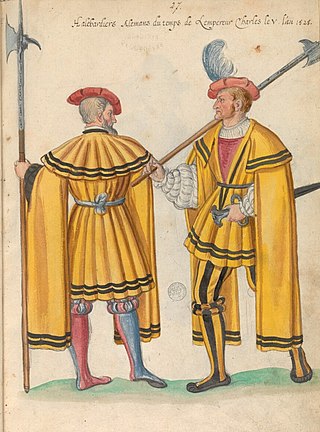
A halberd is a two-handed polearm that came to prominent use from the 13th to 16th centuries. The halberd consists of an axe blade topped with a spike mounted on a long shaft. It can have a hook or thorn on the back side of the axe blade for grappling mounted combatants. The halberd was usually 1.5 to 1.8 metres long.
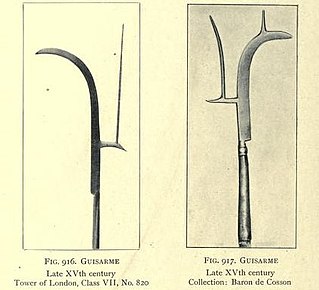
A guisarme is a polearm used in Europe primarily between 1000 and 1400. Its origin is likely Germanic, from the Old High German getīsarn, literally "weeding iron". Like many medieval polearms, the exact early form of the weapon is hard to define from literary references, and the identification of surviving weapons can be speculative.

A bardiche, berdiche, bardische, bardeche, or berdish is a type of polearm used from the 14th to 17th centuries in Europe. Ultimately a descendant of the medieval sparth axe or Dane axe, the bardiche proper appears around 1400, but there are numerous medieval manuscripts that depict very similar weapons beginning c. 1250. The bardiche differs from the halberd in having neither a hook at the back nor a spear point at the top. The use of bardiches started in early 14th-century Austria.

A voulge is a type of polearm that existed in medieval Europe, primarily in 15th century France.

The Dane axe or long axe is a type of European early medieval period two-handed battle axe with a very long shaft, around 0.9–1.2 metres at the low end to 1.5–1.7 metres or more at the long end. Sometimes called a broadaxe, the blade was broad and thin, intended to give a long powerful cut when swung, effective against cavalry, shields and unarmored opponents.

The poleaxe is a European polearm that was used by medieval infantry.
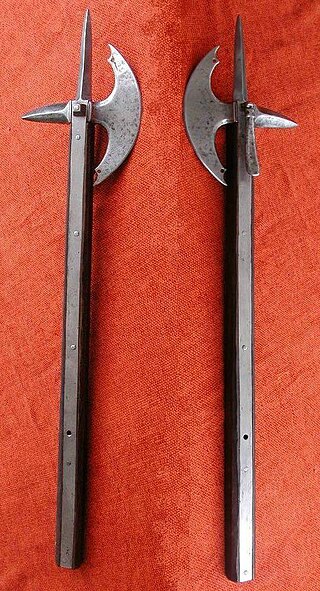
A battle axe is an axe specifically designed for combat. Battle axes were specialized versions of utility axes. Many were suitable for use in one hand, while others were larger and were deployed two-handed.

The dagger-axe is a type of polearm that was in use from the Longshan culture until the Han dynasty in China. It consists of a dagger-shaped blade, mounted by its tang to a perpendicular wooden shaft. The earliest dagger-axe blades were made of stone. Later versions used bronze. Jade versions were also made for ceremonial use. There is a variant type with a divided two-part head, consisting of the usual straight blade and a scythe-like blade.
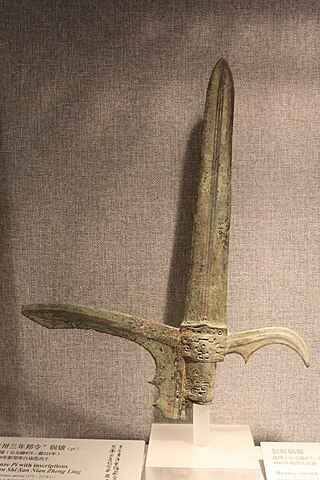
The ji was a Chinese polearm, sometimes translated into English as spear or halberd, though they are fundamentally different weapons. They were used in one form or another for over 3000 years, from at least as early as the Zhou dynasty, until the end of the Qing dynasty. They are still used for training purposes in many Chinese martial arts.
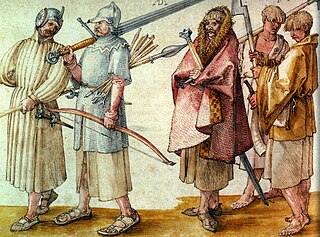
Gaelic warfare was the type of warfare practiced by the Gaelic peoples, in the pre-modern period.

A war scythe or military scythe is a form of pole weapon with a curving single-edged blade with the cutting edge on the concave side of the blade. Its blade bears a superficial resemblance to that of an agricultural scythe from which it is likely to have evolved, but the war scythe is otherwise unrelated to agricultural tools and is a purpose-built infantry melee weapon. The blade of a war scythe has regularly proportioned flats, a thickness comparable to that of a spear or sword blade, and slightly curves along its edge as it tapers to its point. This is different from farming scythes, which have very thin and irregularly curved blades, specialised for mowing grass and wheat only, unsuitable as blades for improvised spears or polearms.

Many of the polearms used in Scotland up to the beginning of the 16th century were similar to those used in other parts of the world; however, a number of distinct forms did evolve. The nomenclature of Scottish axes, in particular, is confusing, and the text below follows the classification scheme proposed by David H. Caldwell in his 1980 paper "Some Notes on Scottish Axes and Long Shafted Weapons".

Warfare in early modern Scotland includes all forms of military activity in Scotland or by Scottish forces, between the adoption of new ideas of the Renaissance in the early sixteenth century and the military defeat of the Jacobite movement in the mid-eighteenth century.
The Jedwart stave was a polearm weapon commonly found in the Scottish Borders in the 16th century. It consisted of a large, thin, double-edged axe-like blade attached to a roughly four-foot long studded stave with a hand guard, similar in appearance to a bardiche. The upheaval of the sixteenth century in the borders proved the weapon to be too light to be effective against the heavy cavalry of the Border Reivers and attacks from the English, and it fell out of favour in combat. It remained however a common household weapon for purpose of self-defence.
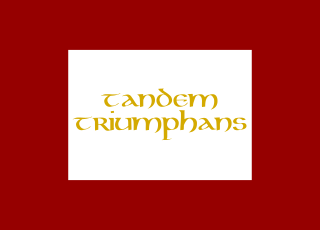
The Jacobite Army, sometimes referred to as the Highland Army, was the military force assembled by Charles Edward Stuart and his Jacobite supporters during the 1745 Rising that attempted to restore the House of Stuart to the British throne.

An Incident in the Rebellion of 1745 is an oil painting, by the Anglo-Swiss artist David Morier. It is part of the art collection of the British royal family. The painting depicts a scene during the 1746 Battle of Culloden, in which a group of Jacobite Army troops charge against a line of government soldiers.